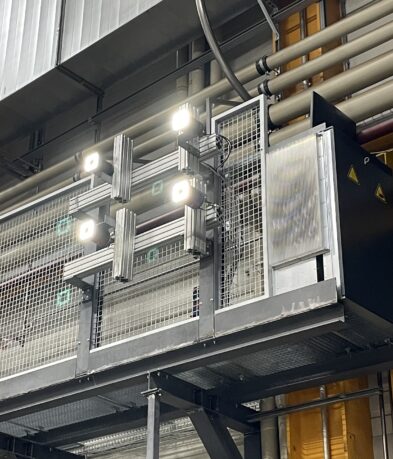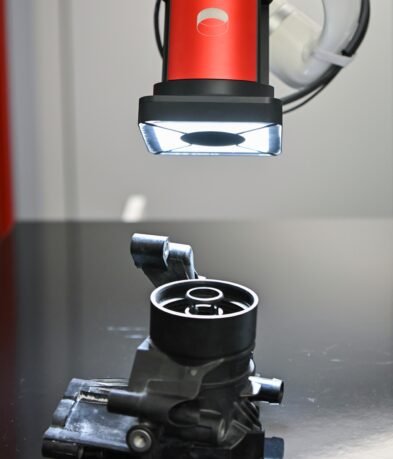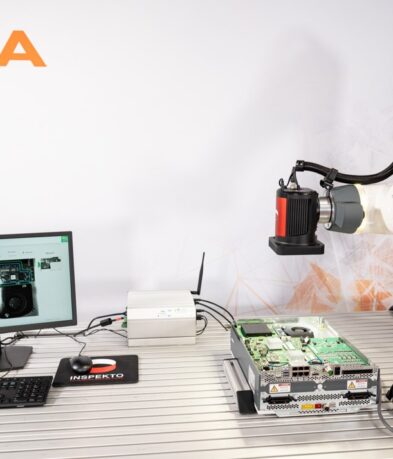BOSCH WAIBLINGEN PLANT UTILISES AUTONOMOUS MACHINE VISION
June 09, 2021
The company tested the world’s first autonomous visual inspection product
In its plant in Waiblingen, Germany, Bosch produces plastic moulded connectors for the automotive sector. Plastic injection moulding is traditionally a difficult application for standard machine vision because of the lack of contrast between the background and the part being inspected – the “black-on-black” nemesis. To solve this problem, Bosch turned to Inspekto, founder of the Autonomous Machine Vision (AMV) category.
The automotive industry’s quality standards place high demands on production. Global competition and market expectations put growing pressures on automotive vendors to enhance their QA procedures, moving away from manual to automated inspection. The challenge is to find and implement cutting-edge machine vision methods.
The problem with injection moulding
“Plastic injection moulding poses a lot of problems for traditional machine vision systems,” explains Zohar Kantor, VP of Sales & Project Management at Inspekto. “The highly reflective surface of plastic is hard to illuminate correctly. In addition, if the background material, the mould and the plastic polymer are a similar colour, and the available illumination is anything but ideal, a lack of contrast can make it very difficult for the machine vision system to work.”
“Combine this with the fact that traditional systems can only inspect one type of product at a time — and manufacturers need to create product lines in different colours and sizes — it’s easy to see why a fundamental change in machine vision is needed.”
This is exactly the problem that Bosch was facing. In Waiblingen, the company produces plastic moulded connectors for vehicles, specialising in motor plugs, device connectors and sensor connectors. The plant has various production lines and injection moulding machines.
“The plant uses conventional state-of-the-art machine vision solutions, some developed internally, some created and integrated by external machine vision experts,” explains one of the development engineers for optical inspection systems at Bosch in Waiblingen.
“However, these solutions are not suitable for some of our applications, where the item that we need to inspect consists of a black polymer on a black background. In these conditions, it is virtually impossible to set the parameters for the QA solution to recognise defects.”
The plant had to check the connectors manually. As this is a tedious, repetitive job, inspectors might easily become tired and unfocused and fail to recognise defects. Moreover, the cost for personnel is significant.
After reading about Autonomous Machine Vision in an industrial report, Bosch decided to approach Inspekto to see if the company could provide a solution for Bosch’s machine vision challenges.
Plug & Inspect ® technology
Autonomous Machine Vision (AMV) is a new category of machine vision for quality assurance invented by Inspekto, a German company with Israeli DNA. In 2018, the company launched its first AMV system, the INSPEKTO S70, establishing a ground-breaking approach to QA.
“The INSPEKTO S70 is the first standalone product for visual QA, gating and sorting,” says Kantor. “It is self-setting, self-learning and self-adjusting and can be used to inspect any item, in any industry, produced with any handling method.”
“The product comes out of the box with everything the user needs to start inspecting products right away. The installation process is designed to be quick and easy. The plant’s own staff can set up and train the system without using an external systems integrator. Most importantly, the S70 only requires an average of 20 to 30 good samples to learn the characteristics of a perfect product. Therefore, there’s no need to set up parameters to train the system to recognise mistakes, like with traditional solutions.”
Because of these advantages, Bosch decided to run a pilot project in Waiblingen and see if it would help where traditional solutions had failed. Inspekto and Bosch started an application partnership and after a few weeks, the first system was ready for use in series production.
“In our area of the business, we are experts in machine vision, so it wasn’t difficult to integrate the system. So, I’m confident that our colleagues in other Bosch plants also would have no difficulty in using Inspekto’s AMV system,” reports one of the development engineers at Bosch. “The initial installation of the pilot system took about an hour, and less than a day if you factor in the small adjustments that we made to optimise the speed of the process. It took another 20 minutes to learn the software programme, and then we just had to plug in the camera and begin inspecting.”
Cost reduction and quality improvement
During installation, the production line kept running as normal and the plant didn’t experience any downtime. “Because the INSPEKTO S70 can run without any input from the control system, it can be installed without affecting production,” says one of the development engineers. “Initially, we had the S70 running in parallel with the production line, where we integrated it mechanically but without connecting it to the machine. The system then learned the characteristics of the product quickly. All of this was done without any impact on production.”
“The cost of the initial system was amortised in under a month and we could immediately see further savings and an improvement in quality. Because the pilot system worked so well, we ordered another one for our subsidiaries overseas, then another one to be installed in an older application here in Waiblingen.”


